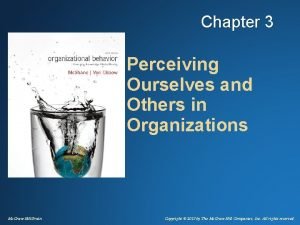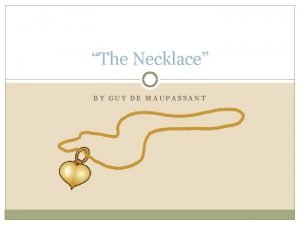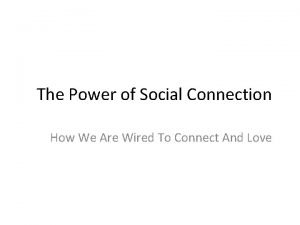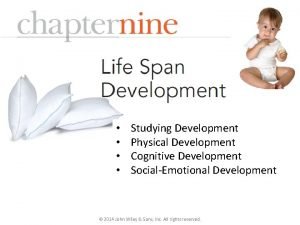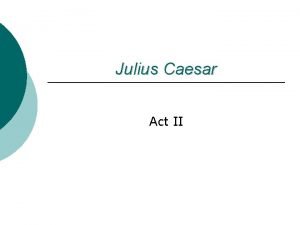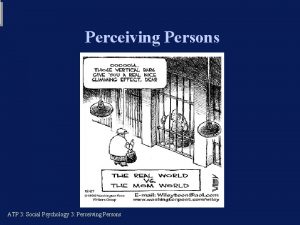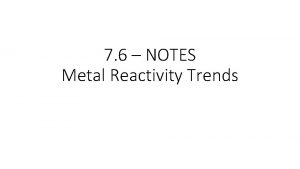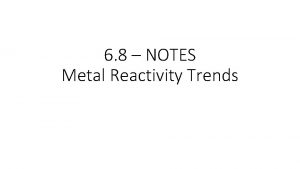Attenuating Anxious Womens Conflict Reactivity Perceiving Partners to















- Slides: 15

Attenuating Anxious Women's Conflict Reactivity: Perceiving Partners to Endorse Benevolent Sexism Cross, Overall & Hammond, PSPB (2016) Emily J Cross, University of Auckland Nickola C. Overall, University of Auckland Matthew D. Hammond, Victoria University of Wellington R. E. A. C. H researching emotions, attachment, close relationships and health www. relationships. auckland. ac. nz

Attachment Anxiety and Conflict Fear rejection and abandonment Crave closeness and intimacy Need reassurance of their partners’ love and devotion Intense insecurity/distress during conflict Conflict activates concerns of relationship loss Perceive their partners’ love is in jeopardy e. g. , Campbell, Simpson, Boldry, & Kashy, 2005; Collins, 1996; Mikulincer & Shaver, 2003; Simpson, Rholes & Phillips, 1996; Simpson & Rholes, 2012; Tran & Simpson, 2009.

Buffering Anxious Reactivity Buffering Attachment Anxiety Anxious Individuals feel more secure when partners are: • overtly affectionate • perceived as caring and available During Conflict when insecurities are activated? § feel more accepted and behave more constructively when partners are highly committed, and thus exhibited more accommodation behavior e. g. Lemay & Dudley, 2011; Little, Mc. Nulty, & Russell, 2010; Simpson & Overall, 2014; Tran & Simpson, 2009 Role of Social Attitudes • Broad factor that signals partners’ value of relationships and future care and devotion • Attitudes that stipulate partners’ sustained investment and devotion should offset insecure reactions during conflict.

The Reassuring Nature of Benevolent Sexism 1. Men's competence & strength complements women's warmth 2. Men are dependent on women to fulfill their intimacy & reproductive needs 3. Men should cherish, protect & provide for women Ambivalent Sexism Theory; see Glick & Fiske, 1996 Why are these attitudes sexist? • Encourages gender roles which confines women to traditional (low power) roles • Undermines women’s ambition, independence and competence e. g. see Dardenne, Dumont, & Bollier, 2007; Dumont et al. , 2010; Feather, 2004; Fernández, Castro, Otero, Foltz, & Lorenzo, 2006; Moya, Glick, Expósito, de Lemus, & Hart, 2007. Security-Enhancing Benefits Should signal to women their partner is the kind of person that will: • prioritize the relationship • remain invested in the relationship • feel less worthy and personally satisfied if they do not fulfill these relationship obligations Perceiving male partners to endorse BS should provide highly anxious women with much needed security!

Hypothesis Perceiving male partners to endorse benevolent sexism means male partners believe that men • need women to be fulfilled • have a responsibility to be chivalrous and reliable partners Providing anxious women…. Perceptions of Partner’s Benevolent Sexism Gender Women only Reassurance that male partners • will not abandon them in the future • will remain invested even when problems exist in the relationship Attachment Anxiety Distress/ Insecurity Perceiving partners to strongly endorse benevolent sexism should attenuate the distress highly anxious women (but not men) experience during conflict.

Method 14 Participants Method & Outcomes Study 1 Study 2 Study 3 78 Heterosexual Couples Age: M = 22. 12 yrs Length: M = 2. 59 yrs Status: 57% Married/Cohab & 37% serious Age: M = 22. 26 yrs Age: M = 35. 92 yrs Length: M = 2. 58 yrs Length: M = 9. 80 yrs Status: 44% Married/Cohab Status: 79% married/cohab & 49% serious During Couples Discussions 21 -day Dyadic Dairy Recalled Conflict Daily Negative Emotions: • “sad about our relationship” • “hurt by my partner” Recalled Negative Emotions & Insecurity (Study 2) • • “how stressful did you find the discussion” “how upset did you feel during the discussion” Daily Insecurity: • “confident that my partner loves me”(RS) • “insecure about our relationship” 250 Heterosexual Women Recalled Relationship Threat: • “I think our relationship might end soon” • “I feel like our relationship is in trouble/jeopardy”

Study 1: Conflict Discussion Perceiving partners strongly endorse benevolent sexism shouldinteraction attenuate the distress Attachment anxiety xto. Perceptions of partners’ benevolent anxiousfor women typically experience • highly significant women (B = -. 29, t = -2. 29, during p =. 03)conflict. • not men (B =. 18, t = 1. 04, p =. 30) • significant gender difference (B =. 24, t = 2. 20, p =. 02) Women only Distress During Discussion 4. 0 3. 5 B =. 80, t = 5. 03, p <. 001 3. 0 2. 5 Low Perceived Partner's Benevolent Sexism 2. 0 1. 5 1. 0 Low Attachment Anxiety High Attachment Anxiety Note. High and low values represent 1 SD above and below the mean Cross, Overall & Hammond, PSPB

Study 1: Conflict Discussion Attachment anxiety x Perceptions of partners’ benevolent sexism interaction • significant for women (B = -. 29, t = -2. 29*, p =. 03) Women only Distress During Discussion 4. 0 3. 5 B =. 80, t = 5. 03, p <. 001 B = -. 37, t = -1. 78, p <. 08 3. 0 B =. 14, t = 0. 55, p =. 58 2. 5 2. 0 Low Perceived Partner's Benevolent Sexism 1. 5 High Perceived Partner's Benevolent Sexism 1. 0 Low Attachment Anxiety High Attachment Anxiety Note. High and low values represent 1 SD above and below the mean Cross, Overall & Hammond, PSPB

Study 2: Daily Conflict Relationship Conflict x Perceptions sexism: Greater anxiety wouldx Attachment be associatedanxiety with greater distressof&partners’ insecuritybenevolent on days that • individuals significant for womenconflict, (B = -. 05, but t =this -3. 82, p <. 001) experienced distress/insecurity would be attenuated when • highly notanxious men (B women =. 01, t =(not 1. 19, p =. 24) men) perceived their partners to endorse benevolent sexism. • significant p <. 001) B: Panel A: gender difference (B =. 03, t = 3. 84, Panel Partners perceived to strongly endorse BS Partners Perceived to weakly endorse BS Distress/Insecurity 3. 5 Low Attachment Anxiety 3. 0 2. 5 B =. 43, t = 19. 51** ** 3. 5 3. 0 2. 5 2. 0 1. 5 1. 0 B =. 25, t = 10. 90** 0. 5 Low Daily Conflict High Daily Conflict B =. 24, t = 9. 95** B =. 21, t = 7. 45** 1. 0 0. 5 Low Daily Conflict High Daily Conflict Note. ** p <. 001, High and low values represent 1 SD above and below the mean Cross, Overall & Hammond, PSPB

Study 3: Recalled Conflict Aim: Replicating this pattern with a older, more committed community sample of women (N = 250) when they recalled experiences of conflict with their male partners. Distress/Insecurity 5. 5 5. 0 4. 5 Low Perceived Partner's Benevolent Sexism High Perceived Partner's Benevolent Sexism B =. 83, t = 8. 49** B = -. 38, t = -3. 99** 4. 0 3. 5 B =. 44, t = 4. 20** 3. 0 2. 5 2. 0 Age: M = 35. 92 yrs (SD = 10. 93) Rel. Length: M = 9. 80 yrs (SD = 8. 91) Status: 79% married/cohabiting **p <. 001 Low Attachment Anixety High Attachment Anixety Cross, Overall & Hammond, PSPB

Study 4: Mechanism Why Benevolent Sexism? Can Rely on Men who Endorses BS to: § sacrifice for, and invest in their relationship, § and feel worthless if they do not live up to their relationship obligations. Perceptions of Partner’s Reliability “My partner is the kind of person who will… 1. “stick by me through good times and bad”, 2. “always put our relationship first”, 3. “make sacrifices to take care of me and our relationship” 4. “feel worthless if he/she thought I was unhappy with our relationship” 5. “feel worthless if he/she could not provide a stable and secure life for us” (α =. 84) Perceived Partner Benevolent Sexism Gender Path A Partner Reliability Path B Attachment Anxiety Distress/ Insecurity Cross, Overall & Hammond, PSPB

Study 4: Partner Reliability Participants 347 individuals (189 women and 158 men) completed online questionnaire. Procedure and Measures Study 3, with one exception: Perceived Partner Reliability measure Gender Path A Partner Reliability Path B Attachment Anxiety The more that 5. 0 women (but not men) perceived their partners Low Perceived Partner Reliability to endorse benevolent sexism, the more they perceived their High Perceived Partner Reliability 4. 5 partner to be reliable Distress/Insecurity Perceived Partner Benevolent Sexism 4. 0 B =. 75, t = 9. 17** Perceiving 3. 5 partners’ to endorse benevolent sexism B = -. 50 t = - to 6. 72** attenuated anxious women’s insecure reactions 3. 0 conflict - because partners were perceived to remain invested in fulfilling their relationship 2. 5 B =. 32, t = 4. 00** obligations. 2. 0 Distress/ Insecurity 1. 5 Low Attachment Anixety High Attachment Anixety Significant Indirect effect for women (point estimate = -. 05, 95% CI = [-. 09, -. 02]), but not men (point estimate = -. 001, 95% CI = [-. 03, . 03]).

Summary & Implications Perceiving partners to endorse benevolent sexism attenuates anxious women’s insecure reactions to conflict. These security-enhancing effects occur because benevolent sexism signals that male partners can be relied upon to remain invested and live up to their relationship obligations. These novel results advance : 1. Attachment literature - what factors can help attenuate threat-based reactions associated with attachment anxiety 2. Sexism literature - the relationship benefits benevolent sexism offers women that mask substantial societal-level costs Cross, Overall & Hammond, PSPB

Thank you Emily J Cross, University of Auckland Nickola C. Overall, University of Auckland Matthew D. Hammond, Victoria University of Wellington R. E. A. C. H researching emotions, attachment, close relationships and health www. relationships. auckland. ac. nz

Why not perceived commitment? Commitment Long-term orientation towards one’s relationship. May provide some reassurance to the highly anxious. But, is closely tied to specific conditions within the relationship (e. g. satisfaction, attractive alternatives; Rusbult, Martz, & Agnew, 1998) which change over time. Commitment fluctuates depending on the state of the relationship (Arriaga, Reed, Goodfriend, & Agnew, 2006). Thus may not always provide enough reassurance to overcome anxious insecurities activated during conflict. Benevolent Sexism Encompasses a broader orientation towards relationships that is independent of current relationship conditions or evaluations. Perceiving male partners to identify with the role-based prescriptions of benevolent sexism should offer women greater reassurance of partner’s • continued availability • sustained investment Identifying with role-based prescriptions offers a higher level and more stable sense of security.
 Perceiving ourselves and others in organizations
Perceiving ourselves and others in organizations Judging vs perceiving
Judging vs perceiving Perceiving order in random events example
Perceiving order in random events example Mbti j p
Mbti j p Closure-oriented/judging vs. open/perceiving
Closure-oriented/judging vs. open/perceiving Perceiving vs judging
Perceiving vs judging Example of overconfidence
Example of overconfidence Why did mr loisel expect his wife to be pleased to receive
Why did mr loisel expect his wife to be pleased to receive Anxious attachment style
Anxious attachment style Apprehensive vs anxious
Apprehensive vs anxious Anxious ambivalent attachment
Anxious ambivalent attachment When my anxious thoughts multiply
When my anxious thoughts multiply Anxiety vs apprehension
Anxiety vs apprehension Ashamed gerund or infinitive
Ashamed gerund or infinitive Why is brutus anxious for the battle to begin?
Why is brutus anxious for the battle to begin? Anxious gerund or infinitive
Anxious gerund or infinitive
